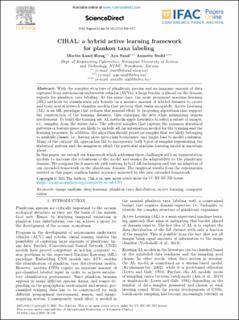| dc.contributor.author | Haug, Martin Lund | |
| dc.contributor.author | Saad, Aya | |
| dc.contributor.author | Stahl, Annette | |
| dc.date.accessioned | 2022-10-12T06:00:09Z | |
| dc.date.available | 2022-10-12T06:00:09Z | |
| dc.date.created | 2021-07-22T10:34:48Z | |
| dc.date.issued | 2021 | |
| dc.identifier.citation | IFAC-PapersOnLine. 2021, 54 (16), 450-457. | en_US |
| dc.identifier.issn | 2405-8963 | |
| dc.identifier.uri | https://hdl.handle.net/11250/3025450 | |
| dc.description.abstract | With the complex structure of planktonic species and an immense amount of data captured from autonomous underwater vehicles (AUVs), a large burden is placed on the domain experts for plankton taxa labeling. At the same time, the most prominent machine learning (ML) methods for classification rely heavily on a massive amount of labeled datasets to create and train neural network classifier models that perform their tasks accurately. Active Learning (AL) is an ML paradigm that reduces this manual effort by proposing algorithms that support the construction of the training datasets, thus enlarging the sets while minimizing human involvement. To build the training set, AL methods apply heuristics to select a subset of images, i.e., samples, from the entire data. The selected samples that capture the common statistical patterns or feature space are likely to include all the information needed for the training and the learning processes. In addition, the algorithm should prioritize samples that are likely belonging to multiple classes, i.e., having close inter-class boundaries, and might lead to model confusion. Many of the current AL approaches fail to incorporate both types of samples representing the statistical pattern and the samples in which the particular machine learning model is uncertain about.
In this paper, we extend our framework which addresses these challenges with an augmentation module to increase the robustness of the model and ensure its adaptability to the planktonic domain. We compare the framework with existing hybrid AL techniques and test an adaption of our extended framework on the planktonic domain. The empirical results from the experiments exerted in this paper confirm higher accuracy achieved by the new extended framework. | en_US |
| dc.language.iso | eng | en_US |
| dc.rights | Attribution-NonCommercial-NoDerivatives 4.0 Internasjonal | * |
| dc.rights.uri | http://creativecommons.org/licenses/by-nc-nd/4.0/deed.no | * |
| dc.subject | Bildebehandling | en_US |
| dc.subject | Image processing | en_US |
| dc.subject | Robotsyn | en_US |
| dc.subject | Robotic Vision | en_US |
| dc.subject | Semisupervised deep learning | en_US |
| dc.subject | Semisupervised deep learning | en_US |
| dc.title | CIRAL: a hybrid active learning framework for plankon taxa labeling | en_US |
| dc.type | Journal article | en_US |
| dc.type | Peer reviewed | en_US |
| dc.description.version | publishedVersion | en_US |
| dc.source.pagenumber | 450-457 | en_US |
| dc.source.volume | 54 | en_US |
| dc.source.journal | IFAC-PapersOnLine | en_US |
| dc.source.issue | 16 | en_US |
| dc.identifier.doi | 10.1016/j.ifacol.2021.10.130 | |
| dc.identifier.cristin | 1922395 | |
| dc.relation.project | Norges forskningsråd: 223254 | en_US |
| dc.relation.project | Norges forskningsråd: 262741 | en_US |
| cristin.ispublished | true | |
| cristin.fulltext | original | |
| cristin.qualitycode | 1 | |

